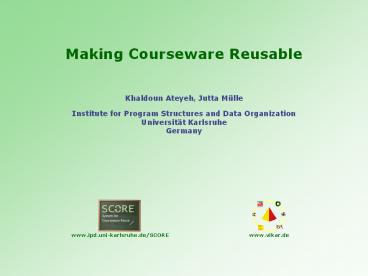Making Courseware Reusable - PowerPoint PPT Presentation
1 / 24
Title:
Making Courseware Reusable
Description:
Metadata is used to describe the various aspects of a learning object ... A set of concept definitions and their relationships ... – PowerPoint PPT presentation
Number of Views:48
Avg rating:3.0/5.0
Title: Making Courseware Reusable
1
Making Courseware Reusable
Khaldoun Ateyeh, Jutta Mülle
Institute for Program Structures and Data
Organization Universität Karlsruhe Germany
www.ipd.uni-karlsruhe.de/SCORE
www.vikar.de
2
Outline
Motivation Why Courseware Reuse Requirements
Our Approach Atoms, Modules, Courses Aspects Mod
ule Types Ontology A Course Development
Process Summary
3
Motivation
- The development of multimedia courseware
- is a very difficult and costly process
- is an interdisciplinary process
- has high requirements on creativity
- has to take psychological and ergonomical aspects
into consideration
Why do we need to reuse Courseware?
4
Motivation Current Situation
- Current courseware tends towards a monolithic
structure mixing content, structure, and
presentation
- Current courseware is difficult to
- extend
- maintain
- update
- reuse
5
Outline
Motivation Why Courseware Reuse Requirements Ou
r Approach Atoms, Modules, Courses Aspects Module
Types Ontology A Course Development
Process Summary
6
Requirements Courseware
- Modular courseware
- Adaptable courseware
- Adaptability to different university types
- Adaptability to students
- Adaptability to educators
- Adaptability to learning form
- Support for cooperation
- Support for open standards
- Effective search and discovery mechanisms
7
Outline
Motivation Why Courseware Reuse Requirements Ou
r Approach Atoms, Modules, Courses Aspects Module
Types Ontology A Course Development
Process Summary
8
Our Approach
- To meet our goals our approach proposes to
- Divide courseware into self-contained learning
modules - Separate different aspects such as content,
structure, and presentation - Use Standardized Metadata
- Create community and domain specific ontology
9
Our Approach Atoms, Modules Course
- The basic building blocks of our solution are
learning atoms - Each learning atom contains a specific learning
unit, say a definition, an example, a proof - Learning atoms that deal with a semantically
closed set of contents form learning modules - a course is composed of modules and deals with a
specific context
10
Our Approach Aspects
- Which aspects should be adaptable?
Content
Structure
Presentation
11
Our Approach Module Types
- Thus, technically a learning module has three
variations
Content
Structure
Presentation
12
Our Approach
Learning Subject
Learning Module
Learning Module
Learning Module
cooperation content
Integration Module
choice, structure, didactics
Structural module
Structural module
Structural module
presentation
Presentational module
Presentational module
Presentational module
Presentational module
Print view
Distance learning view
Print view
Face-to-face view
13
Our Approach Metadata
- Metadata is used to describe the various aspects
of a learning object - Metadata Standards Learning Object Metadata LOM
14
SCORE-Metadata-Standard
General characteristic of the Learning Object
Lifecycle of the Learning Object
Technical Aspects of the Learning Object
Educational Aspects
Structural Relationships to other Learning Objects
Annotation Information
Content Relationship to other Learning Objects in
the Ontology
Type of a learning Module
15
Our Approach Ontology
- A set of concept definitions and their
relationships - A common basis for cooperation and exchange
within one community - A browsing space
16
Outline
Motivation Why Courseware Reuse Goal of
SCORE Our Approach Atoms, Modules,
Courses Aspects Module Types Ontology A Course
Development Process Summary
17
Course Development CourseBuilder
- Define a course structure
- The course structure defines at this stage
- a first outline or a concept of the course
- It includes the separation of the course into
- modules and a specification of each module
- This step could also be conducted later
- (after the search modules step)
Search modules
Define a course structure
Assemble course
Release course
Existing modules
Suitable modules
Course with metadata
Metadata Editor
Export
Module Builder
Ontology Browser
Search
Presentation Generator
Uploader
Structuring Tool
18
Course Development CourseBuilder
- Search modules
- for every specified module search a suitable
- module in module repositories
- the search could be conducted in form of
- queries or browsing an ontology space for
- the subject
Search modules
Define a course structure
Assemble course
Release course
Existing modules
Suitable modules
Course with metadata
Metadata Editor
Export
Module Builder
Ontology Browser
Search
Presentation Generator
Uploader
Structuring Tool
19
Course Development CourseBuilder
- Assemble course
- adapt found modules to specific needs
- develop unavailable modules
- connect modules by adding course specific
- (context specific) materials
- add and extract metadata for the course
- generate a presentation for the course
Search modules
Define a course structure
Assemble course
Release course
Existing modules
Suitable modules
Course with metadata
Metadata Editor
Export
Module Builder
Ontology Browser
Search
Presentation Generator
Uploader
Structuring Tool
ModuleBuilder This tool is used to deal with all
aspects of a module
20
Course Development CourseBuilder
- Release course
- upload and publish course
- export course
Search modules
Define a course structure
Assemble course
Release course
Existing modules
Suitable modules
Course with metadata
Metadata Editor
Export
Module Builder
Ontology Browser
Search
Presentation Generator
Uploader
Structuring Tool
21
Outline
Motivation Why Courseware Reuse Goal of
SCORE Our Approach Atoms, Modules,
Courses Aspects Module Types Ontology A Course
Development Process Summary
22
Summary (1)
- Basic Problem
- Courseware development is extremely costly and
time consuming - Desirable
- Reusable courseware, i.e. create courseware in a
way that allows to use parts of it in other
contexts, for other audiences and by other
educators - this is prevented by monolithic courses
- that do not separate contents from structure and
presentation - do not identify semantic units of teaching
23
Summary (2)
- Our approach
- divide contents into smallest semantic units
- combine related units to form modules
- separate different aspects, in particular
contents, structure, presentation - metadata standards and ontology
- provide tools to help
- devise a course structure
- find existing materials that cover the topics
needed - structure contents according to individual needs
- adapt material to presentation requirements.
24
Thank you!































